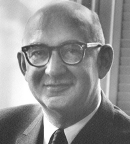Although William Dameshek, MD, is renowned for his work in hematology, especially in advancing the understanding of myeloproliferative disorders and their interrelatedness, his early interest in medicine was instead focused on such diverse diseases as hyperthyroidism and typhus fever.
Celebrating 10 Years of The ASCO Post: A Retrospective
The ASCO Post launched 10 years ago at the 2010 ASCO Annual Meeting. In the coming months, we’ll be publishing a retrospective series of article selections, looking back at some of the highlights published over the past decade. This installment was originally published in The ASCO Post on November 25, 2015.
We would love to hear what The ASCO Post means to you and how we may continue to serve the needs and interests of our readers. Contact editor@ASCOPost.com.
Born on May 22, 1900, in the village of Semliansk near Voronezh, Russia, Dr. Dameshek moved with his parents to Medford, Massachusetts, at the age of 3. An excellent student, he attended the English High School of Boston, one of the first public schools in America, and graduated from Harvard College and then Harvard Medical School in 1923. He married Rose Thurman that same year and had one child, a daughter, Elinor.
It wasn’t until his subsequent internship with Ralph Larrabee, MD—who had established a “blood laboratory” in the basement of Boston City Hospital—that his interest in hematology began to emerge. That inclination was later solidified with the publication of his study on the clinical significance of reticulated red cells in 1926.1
National and International Acclaim
Two years later, Dr. Dameshek became Chief of the Blood Clinic at Beth Israel Hospital in Boston, where he stayed until 1939, before moving to the New England Medical Center (now Tufts Medical Center) to establish and direct the Blood Research Laboratory. It was during his tenure at the New England Medical Center, which lasted 27 years, that his pioneering work in hematology began garnering Dr. Dameshek national and international acclaim. His achievements included landmark studies and publications in the conceptual construct of myeloproliferative and lymphoproliferative disorders and in the development of bone marrow transplantation to treat blood malignancies.
During his time at the New England Medical Center, Dr. Dameshek also held the position of Professor of Medicine at Tufts Medical School and Hematologist-in-Chief at the Boston Floating Hospital and the Boston Dispensary (which was established in 1796 as the first permanent medical facility in New England and one of the first in the United States).

William Dameshek, MD
A tireless organizer and convinced of the importance of an open exchange of scientific ideas, in 1946, Dr. Dameshek and Henry M. Stratton (cofounder of the medical publishing company Grune and Stratton) launched Blood: The Journal of Hematology.
In 1951, while Director of the Blood Research Laboratory at the New England Medical Center, Dr. Dameshek classified polycythemia vera, essential thrombocytosis, and primary myelofibrosis as pathogenetically related myeloproliferative disorders. Although myeloproliferative disorders had been recognized as distinct clinical entities over the previous half century by other physicians and scientists, including William Osler, MD, and Dame Janet Maria Vaughan, Dr. Dameshek is credited with being the first to recognize that these disorders should be classified as a set of phenotypically related diseases.2
In an editorial in Blood in 1951, he argued that given the difficulties in distinguishing among polycythemia vera, primary myelofibrosis, and other myeloproliferative disorders, “perhaps it is possible to resolve all of these dilemmas, conflicts, antagonisms, and confusions by considering, not that the various conditions listed are different, but that they are closely interrelated.”3
Dr. Dameshek’s numerous accomplishments in hematology spanned more than 40 years in medicine. His research and published work included the first-known multi-institutional clinical trial of nitrogen mustard in the treatment of Hodgkin lymphoma, pioneering work in the treatment of immune thrombocytopenia with corticosteroids and in antimetabolite therapy for autoimmune diseases, a proposal that chronic lymphocytic leukemia is the result of a gradual accumulation of lymphocytes, early studies of immunohematology, and theories on the possible interrelationship of benign and malignant lymphoblastic transformations.
A Lasting Legacy
During his nearly 50-year career, Dr. Dameshek saw hematology go from a minor medical discipline to a major scientific field. In addition to his devotion to his patients, he was an inspiring teacher, training more than 100 physicians from 20 countries in the field of hematology. He was also a prolific writer, authoring or coauthoring several books as well as hundreds of papers. Dr. Dameshek remained Editor-in-Chief of Blood until his death 23 years later. He also helped establish the International Society of Hematology, becoming its President in 1954, and was instrumental in the launch of the American Society of Hematology (ASH), which held its first official meeting in 1958. He was named President of ASH in 1964.
In 1966, Dr. Dameshek left the New England Medical Center to take on a new challenge in his career as Professor of Medicine and Attending Hematologist at Mount Sinai School of Medicine (now the Icahn School of Medicine at Mount Sinai) in New York. On October 4, 1969, Dr. Dameshek suddenly fell ill and died 2 days later of a ruptured aorta during open-heart surgery to repair a dissecting aneurysm.
In a tribute to Dr. Dameshek following his death, his friend James L. Tullis, MD, then Chairman in the Department of Medicine at New England Deaconess Hospital and Director of the Cytology Laboratory at the Blood Research Institute, reflected on the totality of Dr. Dameshek’s life. “Despite the wide diversity of his concepts, publications, and travels, his friends will remember him most for his innate humanism. He was always interested in people, whether they were students, patients, or scientific colleagues. He was able to see beyond the limitations of their geographic or ethnic origins and to persuade them to work together toward the larger goals of mankind,” he wrote.4
REFERENCES
1. Dameshek W: Boston Med Surg J 194:759-768, 1926.
2. Levine RL, Gilliland DG: Blood 112:2190-2198, 2008.
3. Dameshek W: Blood 6:372-375, 1951.
4. Tullis JL: Blood 35:1-3, 1970.

